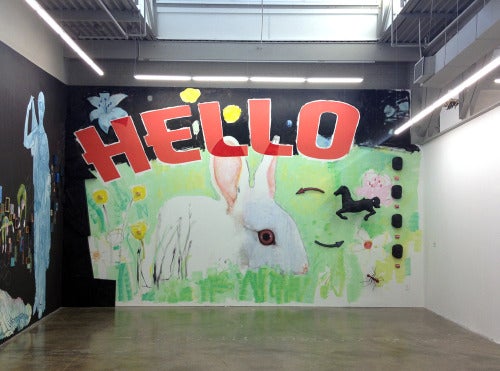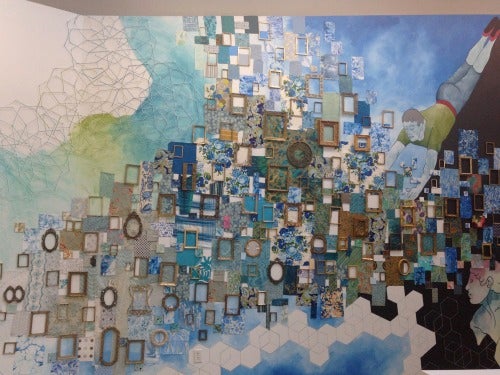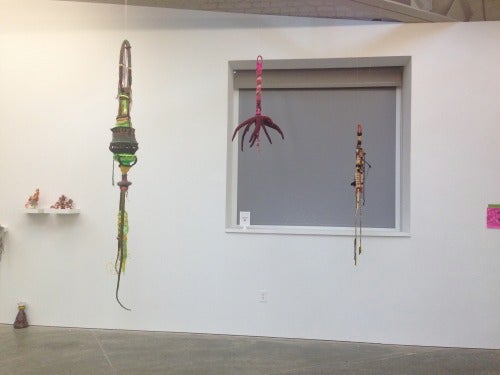
Imagine it’s the early 1920s and you’re playing a traditional “parlor game” with your Surrealist friends. One of them starts a sentence or begins the first illustrative lines of a drawing, then folds the paper and passes it to you. You continue the sentence or drawing without seeing the markings that came before. Then you fold the paper again and pass it to a third person. You are on your way to completing an “exquisite corpse” (from the original term cadaver exquis).
“Exquisite Exhibit: Parlour Games from the Studio Artist Program,” on view through October 11 at the Atlanta Contemporary Art Center, was curated by recent Atlanta expat Joey Orr, who was asked to put together a show with two parameters: he had to include artists from the past decade of the ACAC’s Studio Artist Program, and he had to deliver a show that would serve as the backdrop for this year’s Art Party, which took place on September 13.
With little space or time to organize a survey of the artists’ work, Orr became inventive. He used the seven walls in the gallery to include an impressive amount of the studio artists (21) to collaborate on seven exquisite corpses. Even though this is a large group show, the exhibition doesn’t feel cluttered—it allows for open space and room for the viewer to breathe.

Orr followed the historic tradition of setting guidelines for the game, and he grouped artists for specific reasons. For instance, artists who work in video or, for the expansive walls, those who are accustomed to working big. Orr has proven his curatorial chops with groundbreaking projects for ShedSpace and with his collective John Q. And here he solves the difficult problem of curating for a party while creating a show that has merit.
Artists such as Marcel Duchamp, Joan Miró, Man Ray, and Tristan Tzara participated in this game, as did writer Henry Miller and William S. Burroughs, whose cut-up technique was greatly inspired by this Surrealist invention. The main ambition behind this form of blind collaboration was to create a snapshot of the group’s unconscious reality. The artists in “Exquisite Exhibit” have achieved just that—they have unleashed a group of surprisingly cohesive works that highlight their teamwork as well as the artistic talents of each individual.
Artists Jonathan Bouknight, Michael David Murphy, and Marcia Vaitsman made three thought-provoking video pieces, which I found to be among the best work in the exhibition. They challenged me on both sensory and intellectual levels. In Human Form, we find a top strip of footage showing two wooden boards acting as stilts or legs for a pair of upturned high heels sitting atop them, as if invisible feet dancing on the ceiling. The bottom strip flashes to a pair of legs, repeated and turned upside down, in the process of removing a pair of tights. Together, the two videos create a dialogue addressing gender roles and identity.
Human Figure (Exquisite Corpse) by Jonathan Bouknight, Michael David Murphy, and Marcia Vaitsman on Vimeo.
In Text, by Murphy, Vaitsman, and Bouknight, four lines of black letters in white boxes—“Wheel of Fortune” style—slowly scroll across midscreen, pausing at times so that the fragments form a kind of poetry. One sampling says: “It happened to sensitize the world to the fragile condition of women, not to create women who behave like robotic men.”
In the bottom register, a pair of hands slowly claps, almost elegantly, creating a respite—like doing yoga or drinking a nice cup of green tea—that offsets the rapid incoming of letters, which suggests the media overload that we experience daily.

Lillian Blades, Faith McClure, and Dayna Thacker constructed a wall installation titled Exhibit A. Through Thacker’s minimalist patterning of geometric shapes, I found myself thinking of many different types of systems—how they are the same, how they differ, and how they may be connected.
McClure’s illustrative Greek figures and busts, possessing no eyes or with eyes closed, suggest something more lies under the surface. As human beings, it is up to us whether we want to be engaged and mindful or inwardly focused and egocentric. The figure of an acrobat diving into Blades’s assemblage of fabrics and mismatched frames is dynamic. It would be interesting to see Blades’s quiltlike display in a more all-encompassing installation. I found myself longing to experience her work maximally rather than in small doses.
Rabbits have appeared in Joe Peragine’s work before, and in his portion of a mural completed with Craig Drennen and Gregor Turk, he painted a bunny nestled among loosely configured grass and sunshine yellow flowers that have boxes of Jell-O as their centers. You can’t help but think that this furry creature is welcoming us to the exhibition, with the giant reddish-orange text “HELLO,” provided by Drennan, emblazoned across the top. This sugar shock contrasts nicely with Turk’s black rubberized gear and horse mounted on the wall. As a whole, instead of a harmonious mural, we are met with a collision of the soft and the hard, but it is a satisfying crash.

The only performance element to the show was a part of this piece and consisted of an actor in a white rabbit costume, who appeared in front of the mural during the Art Party. This surprise bunny was no life of the party, but instead a disgruntled wallflower, crouched on the floor with arms crossed in a defensive posture. He was not hopping around with the guests or handing out Easter candy. It was an important reminder that artworks are under no obligation to be friendly and that not every artwork is happy being background decoration for a fundraising event. But rather than making a contentious statement, this withdrawn rabbit added a comic element to the work, allowing guests to chuckle at the costumed creature with a sense of performance anxiety.

Surprisingly, I found the most “traditional” exquisite corpse in the show to be among the most winning. Steven L. Anderson, Craig Dongoski, and Mark Leibert created a collection of framed mixed-media collages, each containing an individual line of witty wordplay, like “Moist Fire Will Meditate On Saturn” and “A Luminous Blade Tickled his Manuscript.” I took pleasure in divining meaning out of the words in relationship to their image pairings.
Each piece looks like a cohesive work, even though the artists were simply doing their own thing and merely hoping for a happy result. The range of materials includes watercolor, turmeric, thread, lemon juice, cyanotype, carbon transfer, fumage, duct tape, and screen print. Though small in scale, these gems were easily a good pick to hold court on an entire wall.
The second room of the gallery is, by comparison, quite explosive, in terms of spatial considerations, variety of mediums, and bold choices in colors and textures. The wall given to Paul Stephen Benjamin, Eric Mack, and Ben Roosevelt, consists of a mantle, delicate collage work, and a tower of television sets. Roosevelt cleverly created his own portion by asking all of the show’s artists to provide objects from their mantles and side tables at home. His mantle is filled with objects such as family photographs, a globe, a stuffed toy monkey, a box of Lego’s, and antlers.

Benjamin’s stack of TVs provides a striking juxtaposition. The media sculpture displayed footage of artists, administrators, and people from the local arts community, including Marianne Lambert, Michael Rooks, Lucinda Bunnen, and the ACAC’s own Rachel Reese. Mack’s wall collage seems to emerge from the five television screens. Looking at Mack’s cloud-shaped creation is almost like glimpsing into the creative minds of the people featured in Benjamin’s footage. Soft colors and fragile textures contrast with bold graphic black patterns, shapes, and schematics.

Another mural, Sweet Sticky Luster, by Sarah Emerson, Matt Haffner, and Michi Meko is a showstopper. Visitors are taken from Easter and bunny rabbits straight to Halloween with a skeleton by Haffner that swarms with shimmery, golden bees. What looks like black honey drips from the skull of the skeleton and here we are brought into the beginning of Emerson’s portion of the mural, where innocence seems to smash into darkness. Cartoony skull heads with solid black rectangles for eyes peer out at us amid a psychedelic landscape. This sweet and spooky scene resembles her past work very closely, and I wonder what she might’ve created had she stepped outside of her comfort zone. The characters of Meko’s contribution could be actors from a film about urban life. Their faces are obscured by inky black shapes, and the low-slung jeans and exposed underwear bring to mind hip hop culture. Belt buckles and watches add a touch of bling, referring back to Meko’s gilded bees. Haffner’s background as a street artist works to his advantage here. His work holds its own in the gallery setting but could also easily do battle (and probably win) against the graffiti that covers the interior of the Krog Street Tunnel.
Artists Laura Bell, Jiha Moon, and Ann Rowles got originative with their offerings, which showcased a collection of sculptural exquisite corpses. One artist would start making the object, and the next person would add something to it. These pieces contain myriad unexpected materials: chopsticks, plastic bottles, glass eyes, doll legs, figurines, a plastic skull, chicken feathers, shells, and a Hacky Sack.

The inclusion of sculptures in the show is refreshing. They are a lesson in achieving aesthetic balance amid a chaotic collection of materials. Some of the pieces look like precious art objects while others take the form of creatures or monsters with tentacles. The hanging sculptures are especially enticing; some look like weird man-eating houseplants or threatening spiders.
Even if you are already familiar with many of the artists in “Exquisite Exhibit,” you haven’t seen this work before because they made it together on site. If all the participants had approached the idea of the exquisite corpse in the same way, this could’ve been a boring show. But, under Orr’s direction, it became an exclamation of inspiring, creative energy.
Sherri Caudell is a poet and writer from Atlanta.





